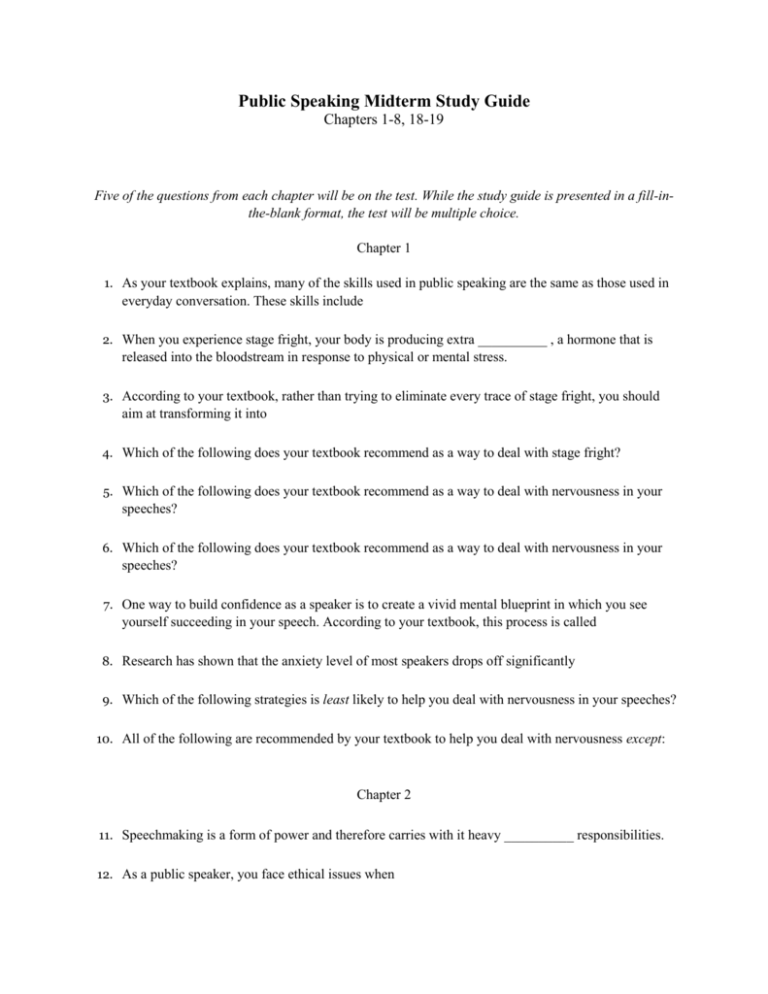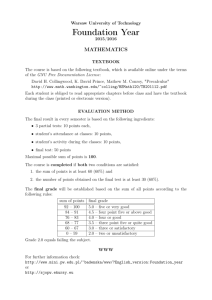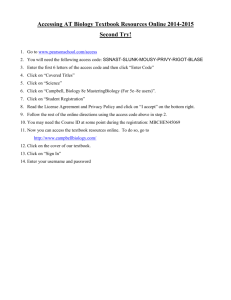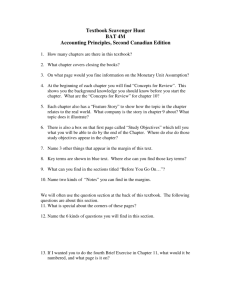Study Guide
advertisement

Public Speaking Midterm Study Guide Chapters 1-8, 18-19 Five of the questions from each chapter will be on the test. While the study guide is presented in a fill-inthe-blank format, the test will be multiple choice. Chapter 1 1. As your textbook explains, many of the skills used in public speaking are the same as those used in everyday conversation. These skills include 2. When you experience stage fright, your body is producing extra __________ , a hormone that is released into the bloodstream in response to physical or mental stress. 3. According to your textbook, rather than trying to eliminate every trace of stage fright, you should aim at transforming it into 4. Which of the following does your textbook recommend as a way to deal with stage fright? 5. Which of the following does your textbook recommend as a way to deal with nervousness in your speeches? 6. Which of the following does your textbook recommend as a way to deal with nervousness in your speeches? 7. One way to build confidence as a speaker is to create a vivid mental blueprint in which you see yourself succeeding in your speech. According to your textbook, this process is called 8. Research has shown that the anxiety level of most speakers drops off significantly 9. Which of the following strategies is least likely to help you deal with nervousness in your speeches? 10. All of the following are recommended by your textbook to help you deal with nervousness except: Chapter 2 11. Speechmaking is a form of power and therefore carries with it heavy __________ responsibilities. 12. As a public speaker, you face ethical issues when 13. In public speaking, sound ethical decisions involve weighing a potential course of action against 14. Which of the following is presented in your textbook as a guideline for ethical speechmaking? 15. Which of the following is presented in your textbook as a guideline for ethical speechmaking? 16. Which of the following is presented in your textbook as a guideline for ethical speechmaking? 17. All of the following are presented in your textbook as guidelines for ethical speechmaking except 18. Which of the following are included in your textbook as guidelines for ethical speechmaking? 19. All of the following are presented in your textbook as guidelines for ethical speechmaking except 20. All of the following are presented in your textbook as guidelines for ethical speechmaking except Chapter 3 21. Even when we are listening carefully, we usually grasp only about __________ percent of what we hear. 22. When business managers are asked to list the communication skills most crucial to their job, they usually rank __________ number one. 23. According to your textbook, effective listening can help you do which of the following? 24. According to your textbook, effective listening skills are important for 25. Sarah is listening to her roommate to provide emotional support in a time of distress. According to your textbook, Sarah is engaged in __________ listening. 26. Fletcher is listening for pleasure as a friend discusses her trip to Australia. According to your textbook, Fletcher is engaged in __________ listening. 27. Julia is listening to her meteorology professor explain how to interpret images from Doppler radar. Because Julia’s goal is to understand the information being presented, she is engaged in __________ listening. 28. According to your textbook, when you listen to evaluate a speaker’s message for purposes of accepting it or rejecting it, what kind of listening is involved? 29. Giving excessive attention to the details of a speech is an example of 30. Which of the following is included among the four major causes of poor listening discussed in your textbook? Chapter 4 31. According to your textbook, a common mistake students make when developing their first speech is 32. Which of the following is appropriate when using humor in a public speech? 33. Which of the following does your textbook recommend for developing your first classroom speech? 34. As explained in your textbook, the three main parts of a speech are called 35. According to your textbook, the first thing a speaker needs to do in the introduction of a speech is to 36. A sentence or two that lets the audience know that a speaker has finished one thought and is moving on to another is called a 37. As your textbook explains, each main point of your first speech should 38. Which of the following does your textbook recommend that you do in the conclusion of your first speech? 39. According to your textbook, the type of delivery in which you plan your speech in detail and learn it well without trying to memorize the exact wording is called 40. According to your textbook, when you prepare speaking notes for your first speech, you should Chapter 5 41. According to your textbook, brainstorming is especially helpful when you are having trouble 42. Which of the following does your textbook recommend as a method of brainstorming for a speech topic? 43. After choosing a topic, what is the next step of speech preparation? 44. Which of the following is out of place in a speech to inform? 45. When the general purpose of your speech is to __________ , you act primarily as a teacher or lecturer. 46. The __________ expresses precisely what you hope to accomplish with your speech. 47. According to your textbook, the specific purpose for a speech should 48. “To persuade my audience to give blood and to support the Wilderness Society” is a poorly phrased specific purpose statement for a classroom speech because it 49. “To inform my audience about the basic steps in car maintenance and how to protect their investment with auto insurance” is a poorly phrased specific purpose statement for a classroom speech because it 50. As a specific purpose statement, “To inform my audience about computer technology” is too Chapter 6 51. As your textbook explains, the primary purpose of speechmaking is to 52. Audience-centeredness means that public speakers should 53. Audience analysis is an important factor in which of the following? 54. Audience adaptation is an important factor in which of the following steps of the speechmaking process? 55. The process by which a speaker seeks to create a bond with listeners by emphasizing common values, goals, and experiences is referred to as ___________ by communication scholars. 56. To say that people usually want to hear about things that are meaningful to them is to say that people are 57. The fact that audiences are egocentric means that 58. The instructor talked about psychographics, what are the two types of audience analysis discussed in your textbook? 59. According to your textbook, which of the following is a demographic characteristic of a speech audience? 60. Creating an oversimplified image of a particular group of people or assuming that all members of the group are alike is called Chapter 7 61. The __________ is the key to finding information in the library. 62. The library catalogue 63. Encyclopedias, yearbooks, biographical aids, and quotation books are all examples of 64. Newspaper and periodical databases 65. A(n) __________ is a research aid that catalogues articles from a large number of scholarly journals. 66. A(n) __________ is a summary of a magazine or research article, written by someone other than the original author. 67. According to your textbook, when is it appropriate to cite an abstract of a magazine or journal article in your speech rather than locating and reading the full article? 68. According to your textbook, you can make a Google search more precise by 69. According to your textbook, Wikipedia is 70. As your textbook explains, one advantage of Wikipedia is that Chapter 8 71. Which of the following is recommended by your textbook as a way to enhance the effectiveness of your examples? 72. Examples are especially helpful as supporting materials because they 73. Research indicates that the impact of examples is greatly enhanced when they are combined with __________ that show(s) the examples to be typical. 74. According to your textbook, a(n) __________ is an imaginary story that makes a general point. 75. Which of the following statistical measures corresponds to what is popularly called “the average”? 76. What is the mean in the following set of numbers: 100, 300, 500, 500, 600? 77. What is the median in the following set of numbers: 200, 300, 500, 600, 600? 78. What is the mode in the following set of numbers: 300, 400, 400, 600, 800? 79. The main value of using statistics in a speech is to 80. To give statistics greater impact, a speaker should Chapter 18 81. One main purpose of a speech of introduction is to 82. Which of the following is recommended by your textbook as a guideline for a speech of introduction? 83. As your textbook explains, when you give a speech of introduction, you should be sure to adapt your remarks to the 84. One method recommended in your textbook for creating a sense of drama and anticipation in a speech of introduction is to 85. According to your textbook, the main purpose of a speech of presentation is to present 86. When giving a speech of presentation, you should usually 87. According to your textbook, a speech in which an individual gives thanks for a gift or award is termed a(n) 88. According to your textbook, in a speech of acceptance a speaker should usually 89. According to your textbook, when your fundamental purpose in a speech is to inspire the audience, you are most likely presenting a(n) __________ speech. 90. As your textbook explains, when giving a commemorative speech, a speaker should take care to Chapter 19 91. As explained in your textbook, one of the defining traits of a small group is that 92. As explained in your textbook, a group member to whom other members defer because of his or her rank or expertise is called a(n) 93. The person who assumes a leadership role in a small group because of her or his ability, personality, or talkativeness is termed a(n) 94. According to your textbook, a small group that meets for only one session should almost always have a(n) __________ leader. 95. According to your textbook, what are the three kinds of leadership needs faced by all problem-solving small groups? 96. Which of the following is a procedural need of a problem-solving small group? 97. According to your textbook, which of the following is a task need of a problem-solving small group? 98. According to your textbook, which of the following is a task need of a problem-solving small group? 99. As your textbook explains, by helping group members deal with interpersonal conflict a leader helps the group fulfill __________ needs. 100. Which of the following is a maintenance need of a problem-solving small group?




